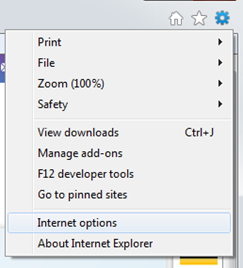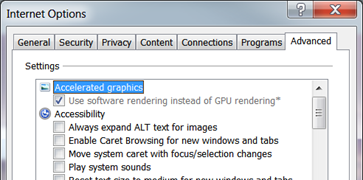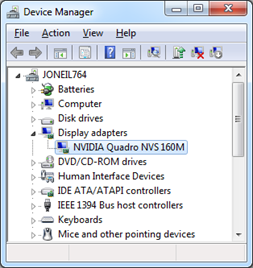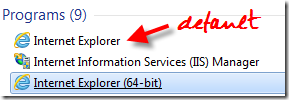IE9… not so fast?
Like many, I installed IE9 today (on two machines, actually). I went right away to the Beauty of the Web to check out some of the cool sites and games that people have been developing with HTML 5, CSS3, and other features of IE9 in mind. One machine worked great; the other was rather sluggish on the Firework Interactive Video and downright dismal on Jitterbugs. So what gives?
GPU > CPU? Not always
As you might know, IE9 was the first browser to introduce hardware-accelerated rendering across the board, but not all GPUs and drivers are created equal. In the beta and RC, you were able to turn off hardware rendering and revert to – generally –slower but perhaps more stable software rendering. So that was the first place I looked – namely the Advanced tab of the Internet options. Right at the top, you’ll see an Accelerated graphics option, and if yours is checked, but disabled, (as mine was) then you’re not getting any of the benefits of hardware acceleration.


Of course if the option is disabled, there’s not much tweaking you can do here! So why’s it disabled? Well, through information collected through beta and RC, Microsoft has compiled a list of scenarios in which the GPU/hardware-accelerated experience may be worse for you: perhaps the GPU and driver combination is actually slower than software rendering or was found to be less stable or secure. IE9 checks against a list of known combinations that produce a less desirable result and opts you in (er…forces you) to software rendering. That list is not static though so as drivers and GPUs mature, it’s updated, and IE9 will re-assess your machine’s capabilities accordingly.
By the way, I have to chime in that I find the UI here counterintuitive. Accelerated graphics is the section title, and generally I’d say, “yeah, I want that” so would be inclined to check the box… but the option is “Use software rendering instead of GPU rendering”, and it’s probably not the option that will provide the best experience. It fails my mother-in-law test too: only a geek can decipher what all that means!
Getting to a happy place
In the meantime though, you might have some luck forcing an update to the latest video drivers on your own. While Windows Update does include driver updates, you may find that something available from your hardware vendor hasn’t quite yet found its way to your machine – and happily that was the case for me.
 First step was determining my video driver – easy enough via Device Manager. From the image to the right, you can see I’ve got an NVIDIA card. (I’ve also used this article in the past to identify my video card, but I can’t vouch for its complete accuracy. Also, there’s a relevant MSDN article from the beta period with a link to a laundry list of driver vendor sites and contact information.)
First step was determining my video driver – easy enough via Device Manager. From the image to the right, you can see I’ve got an NVIDIA card. (I’ve also used this article in the past to identify my video card, but I can’t vouch for its complete accuracy. Also, there’s a relevant MSDN article from the beta period with a link to a laundry list of driver vendor sites and contact information.)
It’s easy enough to update drivers from right in Device Manager: just right-click on the device and pick the Update Driver Software… option from the context menu. I was informed though that I already had the most up-to-date driver.
Leaving no stone unturned, I next visited the NVIDIA site, which like many vendors do, includes an option to download a small plug-in which sniffs out your exact hardware and recommends the appropriate driver update. In my case, there was an update in January 2011, so I installed it… and life is now good (although I can’t say the same for my Jitterbugs high score).
How’s your Chakra (or 64-bit < 32-bit)
Since I was posting on performance, I wanted to throw in an extra little tidbit. It relates not to rendering, but rather to the performance of the multi-threaded JavaScript engine that’s in IE9 – known as Chakra. If you take a look at some of the recent benchmarks on Adrian Kinsgley-Hughes’ blog, you’ll notice some pretty dismal performance by IE9’s 64-bit version.
 Don’t panic! Even though you may be running a 64-bit version of Windows 7, and you (obviously) selected 64-bit when you installed IE9, your default browser is still the 32-bit version of IE. The 64-bit version is also installed, but you have to opt in to using it, and at this point in time there’s not a lot of rationale for doing so.
Don’t panic! Even though you may be running a 64-bit version of Windows 7, and you (obviously) selected 64-bit when you installed IE9, your default browser is still the 32-bit version of IE. The 64-bit version is also installed, but you have to opt in to using it, and at this point in time there’s not a lot of rationale for doing so.
Some insight into the wide variance of performance on the benchmarks between the 32-bit and 64-bit versions of IE9 can be found in Steven J. Vaughan-Nichols’ recent blog post, where he quotes Microsoft’s Tim Sneath, Senior Director of Evangelism:
“…we put all our JIT compiler investment in this release of Chakra into the 32-bit compiler, since that’s the one that is near-universally used today. The 32-bit browser is the default even on 64-bit systems, since almost all add-ons are 32-bit only at this time. The 64-bit version provides no real advantage, since no browser scenario requires access to >2GB of user memory in a single process.”
Moral of the Story…
So if you were scratching your head wondering what all the folks were gloating about in terms of IE9 awesomeness, hopefully the information above sheds some light on your situation. Personally, I’d have liked to see a blatantly proactive message on installing (or running) IE9 - like a bit red sign indicating you’ll get a subpar experience if you don’t update your drivers or hardware. First impressions can be a great asset or a lingering liability, and I’d hate for anyone to dismiss IE9 (or any other product) for a ‘technicality.’
Comments
Anonymous
March 16, 2011
Chase's Secured Customer Account Website and few others secured site can not support IE9.Anonymous
March 16, 2011
My wife is a "Bejewelled Blitz" addict on FB and has found the game to run like a pig since downloading IE9. I'll check out NVidia tonight to see if there are any hardware updates...Anonymous
March 16, 2011
IE would be great if microsoft followed the standards.Anonymous
March 16, 2011
One would think that with all the skilled software engineers working for Microsoft they would just come up with a single browser that would automatically run in either 32- or 64-bit systems. I don't need to tell my mother-in-law that she needs to run the 32-bit (the what???!) IE9 browser on her 'puter.Anonymous
March 16, 2011
Bob, that's a pretty general statement... what specifically are you seeing in IE9 that is not following standards? There are a number of posts on the IE blog (including: blogs.msdn.com/.../web-standards-from-working-draft-to-recommendation.aspx) talking about implementation of IE9 and adherence and adherence to the emerging W3C HTML 5 standard. If you note specific features/behaviors that are not compliant, please raise them up.Anonymous
March 17, 2011
bob, "IE would be great if Microsoft followed the standards." You can say that about any and all browsers. There are some 'standards' IE9 dose not yet have, but there are a number of 'standards' that Mozilla doesn't support or correctly support. PS. There are also some 'standards' that IE9 support that others don't.Anonymous
March 17, 2011
PlumJava, well actually you could say 32-bit IE is just that; it runs on both 32-bit and 64-bit systems. The case for 64-bit IE is a bit tenuous, since many plug-ins don't work well (at all?) in 64-bit, so to some degree it may be a bit early for it to be in the mainstream (I obviously don't the decisions on what to ship/install <g>). As for the mother-in-law test, I'd say it passes this fine, because 32-bit is the default; you don't have to tell her anything. In fact, it's the somewhat technical literate (like Adrian) that get into trouble because they (we) are more likely to ferret out a 64-bit version and give it a whirl.Anonymous
March 17, 2011
David, regarding Chase's site, you might want to submit feedback to them. I can't say for sure what the problem is, but some sites have some historical IE 'fixes' that may or may no longer be appropriate. I'm also aware of another site with some 3rd party software that has a bug when used with IE9 - the best course is to let the webmaster know. In terms of using the site, remember you can get into compatible mode by clicking the 'broken page' icon right after the address bar. And if you're really looking to dig, use F12 - the Developer Tools - and you can make the page behave in IE7, IE8, or IE9 mode (among a lot of other cool things).Anonymous
March 17, 2011
The comment has been removedAnonymous
March 17, 2011
Let users turn off ClearType.Anonymous
March 19, 2011
My son is a fan of danball's powder game and it don't load in IE9. says a problem with this website caused the tab to be closed then reopened..then says "website restore error" and explains when a websites causes IE( to crash it tris to reopen it, but only twice so no endless loop..yet it worked fine in IE8.Anonymous
March 21, 2011
Wes, regarding turning off ClearType - this isn't exactly what you were looking for, but may be of interest: blogs.msdn.com/.../sub-pixel-fonts-in-ie9.aspxAnonymous
March 21, 2011
Larry, I just gave that site (http://dan-ball.jp/) a try. I didn't have a JRE loaded, so downloaded the latest and it seems to be fine. You might check out the version you have (via the Manage Add-ons) menu to see if an update is warranted as well as to see if there are other add-ons that may not be playing well.Anonymous
March 27, 2011
I tried to install ie9 on my PC..i had to wait for about an half an hour to complete the download..and then it keeps hanging again and again...i had to uninstall it but i really wanted to try using it so i called for technical support at 18554252273..they accessed my system remotely and downloaded it for me for free..i am now using it happily i like the new look its faster and easy to use..plus with the bing search function enabled its now good to work on ie9... :)Anonymous
March 27, 2011
Thanks for the informationAnonymous
May 28, 2011
IE9 is not compatible with BT/Yahoo classic mail. Had to change to Google Chrome.Anonymous
October 08, 2011
Bob and some others, IE9 is MORE adherent to standards, which actually began in IE8. The problem is that before standards evolved enough to do things people wanted, IE, Netscape, etc., all came up with their own ways of doing things. That's what "Compatibility Mode" is about in IE -- enables backward compatibility with NON-STANDARD-BASED WEB PAGES.Anonymous
July 26, 2012
I came to this page via a TechNet suggestion. Respectfully, this information is too general & already widely known. I was expecting some very specific tweaks.Anonymous
July 27, 2012
The comment has been removed